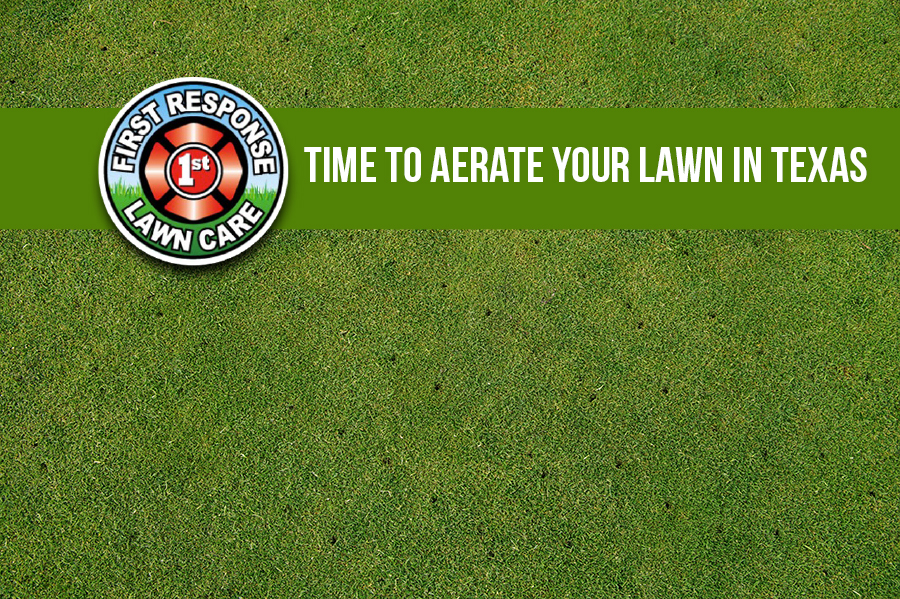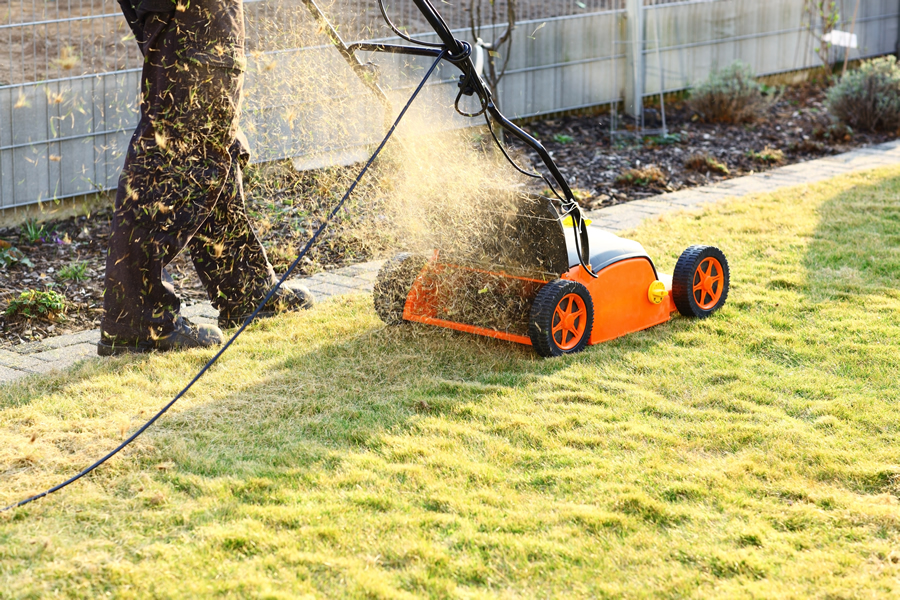
by admin | Jul 21, 2017 | Aeration, Lawn Aeration Rockwall, Lawn Care Royse City
Mushrooms are actually part of a fungus that grows underground, hidden from sight. Lawn fungi and their mushrooms don’t harm a lawn. They’re actually good guys in the ecosystem of your yard, breaking down organic material into nutrients your lawn can use. When most people hear the word “mushroom,” they think of the typical umbrella-shaped one, which is sometimes called a toadstool. Common names for lawn fungus, include puffball, shaggy mane, Japanese parasol or the oddly shaped and smelly stinkhorn.
Common Causes and Solutions
Fungi living beneath lawns are usually long-lived organisms that produce mushrooms when conditions are right. The top reasons mushrooms occur are buried organic matter, high moisture and low light.
Cause: Buried organic matter
A fungus grows by breaking down organic matter. In a lawn, that organic material could be buried timber, a stump, or tree or shrub roots that remain underground after plants have been removed.
Sometimes you can hasten the material’s breakdown by applying nitrogen fertilizer. Use a readily available nitrogen source, not a slow-release one. Aim for a rate of 1/2 to 3/4 pound of actual nitrogen per 1,000 square feet of lawn. If you don’t mind disturbing your lawn, you can also try digging up the organic material.
Cause: High moisture
Periods of prolonged rain can coax mushrooms to form, as can overwatering a lawn. Heavily compacted soil and a thick thatch layer can create drainage problems, which provide ideal growing conditions for mushrooms.
Solution: While you can’t do much about overabundant rainfall, you can address lawn watering practices. Aim for deep, infrequent lawn watering, which encourages turf to develop an extensive root system. Learn tips for lawn irrigation.
For drainage issues caused by compacted soil, try aerating your lawn. If your lawn needs to be aerated, check out our services below.
Lawn Aeration

by admin | Jun 23, 2017 | Aeration, Lawn Aeration Rockwall, Lawn Care Royse City
For warm season grasses, like those you find in our great state of Texas, you should aerate in the early summer. Why? Because warm-season grasses begin their period of active growth in summer. If you aerate a warm-season lawn in late spring to early summer, the ensuing period of rapid growth will quickly fill in the holes you create. If you have Bahia grass, Bermuda, Buffalo grass, Centipede grass, St. Augustine or Zoysia grass, you have a warm season grass.
Aeration Tips
• Follow up the aeration treatment with fertilizing or reseeding your lawn since aeration creates openings for nutrients and seed to penetrate soil.
• The process of aerating can spread weed seeds or portions of weedy roots. Be sure to control weeds prior to aerating.
• If you have a newly planted lawn, wait for at least one year to aerate. This time lapse will ensure that the grass is well established.
• Aerate when soil is moist, but never when it’s saturated. The tines of a lawn aerator penetrate moist soil more deeply; soil that’s too wet clogs tines and isn’t as effective. To achieve the correct moisture balance, your lawn should absorb 1 inch of water – delivered through rainfall or irrigation – prior to aerating. This may mean you’ll water for one hour one day prior to aerating or, if your soil is hard, for shorter times on several days prior to aerating.
• Avoid aerating during drought or high heat. You’ll stress the lawn by allowing heat to dry soil If you aerate in these conditions,
• Plugs should be left on the lawn following aeration, as they contain soil microorganisms that help to break down thatch. These plugs disappear in a short period of time when left on the surface of the lawn.
Call First Response Lawn Care today if you have questions about aerating your lawn. Our technicians are trained to aerate at the optimum time for your soil conditions, giving you the best-looking lawn in the neighborhood.
Lawn Aeration

by admin | Mar 31, 2017 | Irrigation Rockwall, Landscaping Rockwall, Lawn Aeration Rockwall, Lawn Care Royse City
Spring Landscape Planning
There are a lot of landscaping and gardening procedures that you can plan for in early spring. Call First Response Lawn Care today at (214) 701-7622 to discuss your landscaping needs and ideas for this coming Spring and Summer.
Spring weeding
Begin your gardening and landscaping design now, and remember that it is never too early to weed. Weeds that have seeded in your soil are just waiting to sprout up at the first sign of Spring. Our pre-emergent services are ideal for this time of year, and getting an early start in weed control will save countless hours rectifying any unwanted growth when the sun starts shining.
Soil prep
Whether you plan on adding new shrubs, grass, or a vegetable gardens this year, we can start prepping your soil early. Soil prep will ensure young plant health. Aerating and fertilization are best stated earlier in the season as well. Breath-ability must be preserved for healthy soil.
Irrigation
It’s never too early (or late) to plan your irrigation. A sufficient irrigation system will make sure that your plants always have the optimal amount of water. If you already have an irrigation system set up, now is the time to check for broken sprinkler heads and leaks. Get your system up to par before the sun hits and any issues prevent your lawn from getting the hydration it needs.
Spring Cleaning
We can handle your spring cleaning chores by clearing out broken branches, leftover leaves, and all of the other winter debris and trash that has accumulated.
If you take the rights steps now, your garden or yard will be completely ready for the spring planting season.
Call us today – (214) 701-7622 and ask about our landscaping services and be ready for the spring planting season.
For more information about First Response Lawn Care’s services click on the banner below.
Landscaping

by admin | Feb 24, 2017 | Lawn Aeration Rockwall
In order to achieve and maintain a beautiful lawn, it is important to ensure that nutrients can reach the soil beneath your grass. Aeration allows air and water to penetrate built-up grass or lawn thatch.
WHAT IS AERATION?
Aeration involves perforating the soil with small holes to allow air, water and nutrients to penetrate the grass roots. This helps the roots grow deeply and produce a stronger, more vigorous and healthy lawn.
The main reason for aerating is to alleviate soil compaction. Compacted soils have too many solid particles in a certain volume or space, which prevent proper circulation of air, water and nutrients within the soil. Excess thatch or organic debris buried under the grass surface can also starve the roots from these essential elements.
Should You Be Aerating Your Lawn?
One of the most common questions from homeowners is how to determine if they should be aerating their lawn. Your lawn is probably a good candidate for aeration if it:
• Gets heavy use, such as serving as the neighborhood playground or racetrack. Children and pets running around the yard contribute to soil compaction.
• Was established as part of a newly constructed home. Often, the topsoil of newly constructed lawns is stripped or buried, and the grass established on subsoil has been compacted by construction traffic.
• Dries out easily and has a spongy feel. This might mean your lawn has an excessive thatch problem. Take a shovel and remove a slice of lawn about four inches deep. If the thatch layer is greater than one-half inch, aeration is recommended.
• Was established by sod, and soil layering exists. Soil layering means that soil of finer texture, which comes with imported sod, is layered over the existing coarser soil. This layering disrupts drainage, as water is held in the finer-textured soil. This leads to compacted conditions and poor root development. Aerating breaks up the layering, allowing water to flow through the soil more easily and reach the roots.
When to Aerate Your Lawn
The best time for aeration is during the growing season, when the grass can heal and fill in any open areas after soil plugs are removed. Ideally, aerate the lawn with cool season grass in the early spring or fall and those with warm season grass in the late spring.
Aeration is a beneficial practice toward achieving a beautiful lawn, but most people don’t realize it or understand the process. If your lawn is a candidate, make it an integral part of your lawn care regime. Your lawn will thank you for letting it breathe again.
You can count on First Response Lawn Care for your lawn maintenance. Still not sure if your lawn needs aeration? Call us today at (214) 701-7622!




